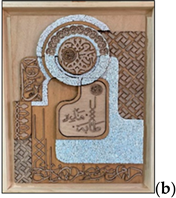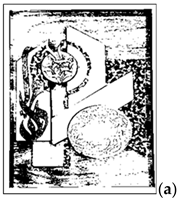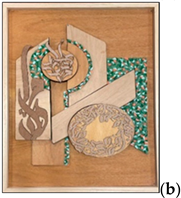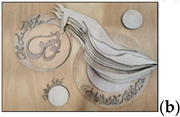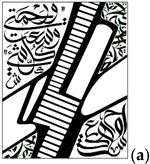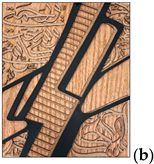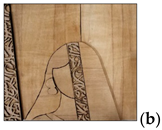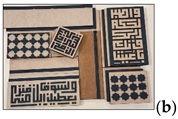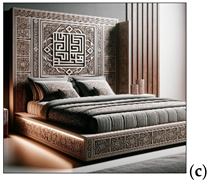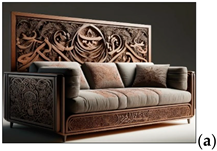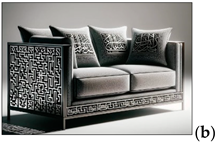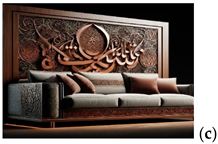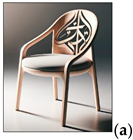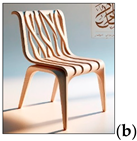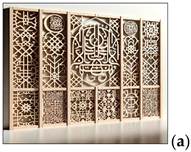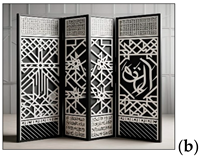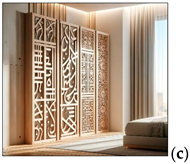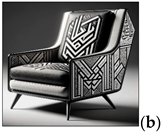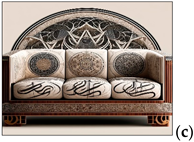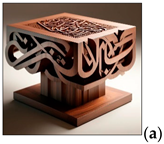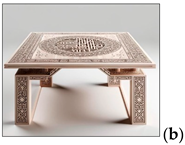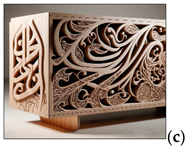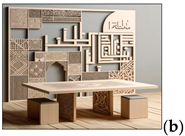Abstract
Sustainability is a modern design philosophy, and this concept prompted this study to focus on the possibility of achieving sustainability principles practically by using artificial intelligence techniques to create sustainable contemporary furniture elements inspired by the heritage and arts of Arabic calligraphy. Heritage-inspired design has cultural meaning and significance as a type of sustainable thinking. Arabic calligraphy has multiple forms and the possibility of adapting it, in addition to its role in enriching the cultural and creative stock. This study aimed to benefit from Arabic calligraphy as a source to enrich and sustain furniture design that is characterized by authenticity and modernity, and to preserve a heritage design product by reformulating it using artificial intelligence methods. In a way that enhances belonging and preserves the community’s heritage and values from extinction, this study followed the descriptive analytical approach in identifying the origins and characteristics of Arabic calligraphy, analyzing its vocabulary, reformulating it, and drawing inspiration from it to enrich furniture designs, in addition to the experimental approach in the applied study through the use of different techniques and materials. The results of this study concluded that there are various aesthetic values in the use of Arabic calligraphy that can be used to create contemporary furniture designs using artificial intelligence techniques to preserve its sustainability. In addition to opening up broad possibilities for creativity and innovation by integrating Arabic calligraphy into furniture design using artificial intelligence technology, this study recommended the need to pay attention to studying the sustainability of heritage and arts in general in appreciation of art and its preservation.
1. Introduction
Arabic calligraphy is one of the most prominent visual arts that distinguished Arab and Islamic culture. It is considered an authentic art of importance among the arts, and calligraphy has a vital role and a profound impact on understanding, knowledge, and the embodiment of ideas. Arabic calligraphy stems from a purely Arab spirit, a spirit that was strengthened when it was linked to the Holy Quran, and Muslims admired it. The matter did not stop at this point, but rather became linked to the aesthetic, emotional, and religious aspects [1].
As both a spiritual expression and a cultural identifier, Arabic calligraphy evolved into a highly stylized art form with elaborate compositions and deeply symbolic meanings. Over time, it became a design language, used in religious architecture, manuscripts, decorative arts, and more recently, in contemporary art and product design. Its visual identity, formed through precise geometric systems and proportional balance, lends itself to traditional and innovative reinterpretations. Arabic calligraphy encompasses various styles, such as Kufi, Naskh, Thuluth, Commentary, Diwani, and Raq’ah, each following distinct visual rules that offer a rich vocabulary for designers to work with [2].
Despite the growing use of Arabic calligraphy in modern creative disciplines, much of the work remains limited to aesthetic or symbolic applications, often overlooking its potential for functional integration. Additionally, while artificial intelligence (AI) has become an increasingly important tool in generative design, few studies have combined AI with culturally rooted content like Arabic calligraphy to explore practical, user-oriented design outcomes, particularly furniture design [3].
This research addresses that gap by exploring how AI applications can transform Arabic calligraphic art into functional and sustainable furniture elements. It introduces a novel method of employing Adobe Firefly and ChatGPT 40 DALL-E, two accessible and advanced generative AI platforms, to generate, interpret, and adapt calligraphic forms into three-dimensional furniture designs. Unlike prior studies that applied AI in broad design contexts, this study focuses specifically on the intersection of cultural identity, design functionality, sustainability, and technology, offering a comprehensive framework for innovation rooted in heritage.
By experimenting with hand-drawn Arabic calligraphy and processing it through AI tools, this study generates a collection of original furniture pieces that embody both aesthetic depth and cultural meaning. Furthermore, using wood as a sustainable material supports eco-conscious design, aligning with global efforts to promote environmentally responsible practices in creative industries. Ultimately, this study positions Arabic calligraphy as not only a traditional artistic expression but also as a dynamic design language capable of evolving through modern technological applications. It demonstrates how culturally inspired design can remain relevant in today’s fast-changing creative landscape by harnessing the power of AI to sustain, celebrate, and reinterpret heritage in meaningful and practical ways.
This study uniquely combines Arabic calligraphy, artificial intelligence (ChatGPT 40 DALL·E), and sustainable wood furniture in a structured experimental framework, drawing inspiration from the authors’ original hand-drawn artwork. We used a pre- and post-design analysis method to quantitatively evaluate improvement using expert panels, which has not been addressed in the previous literature.
2. Literature Review
The integration of Arabic calligraphy into contemporary art and design, particularly through the use of educational strategies and artificial intelligence (AI), represents a compelling exploration of how traditional cultural practices can be preserved and adapted in modern contexts. This literature review examines multifaceted approaches to Arabic calligraphy, focusing on its pedagogical significance, technological integration, and cultural preservation. Pedagogical approaches emphasize the importance of incorporating Arabic calligraphy into educational curricula to enhance students’ appreciation and understanding of Islamic art, which can foster deeper cultural identity and creative expression [4].
Ahmed [5] addresses the importance of using artificial intelligence (AI) in the sustainable furniture design process. The study aimed to provide insights into the potential application of AI in sustainable furniture design and identify the problems faced by furniture designers when using AI in the design process. It demonstrated the role of AI in helping furniture designers create innovative, sustainable, and effective designs. There are several challenges in using AI in the design process, including the lack of appropriate datasets, limited understanding of AI technology, and the need for a collaborative design process. The study provided an analysis of the challenges faced by furniture designers when using AI in sustainable furniture design and proposed solutions to overcome these challenges.
Nehal [6]. conducted a study on the role and importance of artificial intelligence (AI) as it enables innovative applications in furniture that are presented in generative models. It aimed to clarify the current AI techniques applied in furniture design to develop the design process and enhance the capabilities and performance of furniture designers in their work. The study presented two models: the first for the design process to distinguish between human-made design and AI-implemented design. The second model illustrates the role of the furniture designer within AI systems for the design process. The results indicated that 89.4% of furniture designers believe that AI performs better in generating initial ideas compared to other design tasks; 87.2% believe that AI is insufficient without the participation of designers; 72.3% believe that AI is a professional design tool that can enhance interactive design and virtual design; 78.7% fear losing their identities as designers due to the use of artificial intelligence technologies.
Dina and Revenio [7]. addressed the integration of artificial intelligence into the development of the future design process and focused on the development of furniture design. The study explained how to use machine learning techniques and apply them to the design process. The study provided a detailed analysis of the topics that include artificial intelligence in design applications, and the development of furniture using technology in the new era that moves from smart furniture to artificial intelligence furniture. Tables, figures, and images were presented to provide a clear understanding of the process and development of furniture design using different technologies and information analysis. The results of the study revealed that the development of artificial intelligence furniture greatly improves the use of technology, which proves the improvement in product quality and production efficiency in furniture manufacturing. In addition, the integration of artificial intelligence into the interior design process enhances the creative aspect and diversity in design.
Hassan [8] explored the evolving role of artificial intelligence in the creative process, particularly in fields like art and design. His study examined how AI technologies influence innovation by presenting applied models of artificial creativity, including generative networks used to create images and designs. Hassan’s findings emphasize that, while AI tools can significantly enhance human creativity and offer innovative solutions, they still face limitations in fully grasping human and cultural nuances. This suggests that AI serves best as a complementary tool rather than a replacement for human creativity.
Ahmad et al. [3] The research addressed the organic philosophy in Islamic art, with a focus on Arabic calligraphy. The research reviewed the development of Arabic calligraphy throughout the ages, highlighting the influences of the social and political environment on its formation. It also demonstrated how Arabic calligraphy is considered an expression of cultural and religious identity. The research concludes that the organic philosophy in Islamic art and Arabic calligraphy not only reflects aesthetic values, but also demonstrates how art can be a means of enhancing identity and belonging. This concept is manifested through decorative and geometric patterns that reflect unity and harmony in designs. The study also emphasized how artists used plant and geometric shapes to create organic designs that combine repetition and symmetry, while highlighting the spiritual and aesthetic aspects of these arts. The research also highlighted the vital role of Islamic art in shaping cultural identity, reinforcing the importance of studying this art in contemporary educational contexts.
Afifi [9] focused on the application of AI in sustainable furniture design. The study identified the growing interest in using AI to develop eco-friendly and efficient furniture solutions. Afifi analyzed the specific challenges designers face when applying AI in this context and proposed targeted tools and strategies to overcome these barriers. The research concluded that AI holds strong potential to improve the sustainability and innovation of furniture design when these challenges are addressed.
Mahmoud [10] examined the impact of AI on creativity within graphic design. His study highlighted the rapid advancement of AI in this field, noting its role in helping designers generate original and diverse visual content. Mahmoud’s findings underline that AI enhances, not replaces, human creativity and significantly boosts design productivity and innovation. He advocated for viewing AI as a vital support system in the graphic design process rather than a standalone creator.
Together, these studies underscore the importance of Arabic calligraphy in enhancing creative industries and providing educational experiences that connect traditional art with contemporary design needs through innovative academic and technological methods. In particular, integrating artificial intelligence opens up new possibilities for applying Arabic calligraphy in design, ensuring its continuity and development in the digital age.
While previous studies applied AI to explore generative creativity or cultural motifs separately, this study uniquely bridges these themes by using AI to transform original Arabic calligraphy artwork into practical, sustainable furniture, thereby combining cultural preservation with modern design technology.
Comment on Previous Studies
- -
- By reviewing previous studies, it is noted that some of them used the effectiveness of technology-based programs and artificial intelligence in employing Arabic calligraphy as a heritage in some interior designs and spaces.
- -
- The studies agreed on a common goal: to employ Arabic calligraphy in spatial designs through experimentation in different ways.
- -
- Some previous studies agreed with the current study in some procedures, such as using furniture pieces in interior design, practical experience, and tools.
- -
- Most studies relied on the semi-experimental approach and art-based programs, and others on the descriptive approach, and all of them came out with results of the effectiveness of those tools used, but this study used the descriptive, analytical, and experimental approach.
- -
- Most studies dealt with various variables, but this study focused on the wood material as a variable in its employment in furniture pieces.
- -
- A review of previous studies indicates that the current study agrees with previous studies in its general objective, which is to use artificial intelligence technology to employ the art of Arabic calligraphy in interior furniture pieces.
The current study will benefit from previous studies in selecting the sample, the methodology followed, and the tools used after developing them for the study and its community.
3. Problem Statement
Arabic calligraphy is a culturally rich art form known for its aesthetic depth and historical significance. Despite its value, its role in contemporary interior and furniture design is often limited to surface decoration, lacking deeper functional integration. At the same time, artificial intelligence (AI) is emerging as a powerful tool in design fields, yet current research rarely explores how AI can work with traditional, hand-drawn Arabic calligraphy to create modern, functional design outputs. This study addresses a clear gap in the literature: the absence of design methodologies that begin with original, manually crafted Arabic calligraphy and use AI tools to generate culturally expressive and functional furniture. Most existing approaches rely on digital prompts or generic models, missing the opportunity to start from authentic, artistic input grounded in heritage. The research investigates how AI tools, specifically DALL·E, can transform the author’s Arabic calligraphy artwork into innovative furniture designs that merge cultural identity with modern interior design practices.
4. Study Objectives
- -
- Preserving Arabic cultural identity through the integration of calligraphy in furniture design.
- -
- Evaluating the functional and aesthetic values enhanced by the application of AI in furniture design.
- -
- Assessing how AI applications contribute to the sustainability of heritage elements in furniture.
- -
- Identifying differences in expert judgments on AI-generated designs across aesthetics, functionality, and sustainability.
- -
- Establishing a connection between traditional Arabic calligraphy and modern design requirements using AI tools.
5. The Importance of This Study
- -
- Preserving the cultural heritage of Arabic calligraphy as an important element of Islamic culture and art by integrating it into interior design practices to ensure its sustainability and development with technological advancement.
- -
- Innovation in art and design through artificial intelligence technologies and the use of Arabic calligraphy art, which encourages the development of design ideas.
- -
- Technological progress and sustainability, as artificial intelligence helps sustain the art of Arabic calligraphy and addresses the technical challenges of preserving traditional arts.
- -
- Promoting creative ideas by integrating traditional Arabic calligraphy art forms with artificial intelligence applications. This preserves traditional arts and stimulates economic opportunities in the arts and design sectors by expanding how these traditional forms can be explored commercially and artistically.
- -
- Promoting cultural exchange through using Arabic calligraphy art and linking it to artificial intelligence, and then displaying and marketing design ideas to multiple segments of society.
In general, this study addresses how to preserve traditional cultural practices of Arabic calligraphy art and integrate them dynamically by employing artificial intelligence in contemporary environments, ensuring that they remain vibrant and relevant in an increasingly digital world.
6. Study Limits
- -
- Subject limits: Functional and aesthetic values, sustainability values, and furniture elements values. And artificial intelligence applications through the ChatGPT DALL-E program.
- -
- Time limits: The first semester of the academic year 2024 to apply the study tool.
- -
- Spatial limits: King Faisal University.
- -
- Human limits: The current study was limited to selecting works from the activities of researchers in the art of Arabic calligraphy.
7. Study Questions
- How effective are artificial intelligence techniques in employing the art of Arabic calligraphy in contemporary furniture design on the three axes (furniture elements, function and beauty, and sustainability)?
- What is the degree of impact of artificial intelligence applications on the design of furniture elements?
- To what extent are the aesthetic and functional aspects of wood material achieved in the design of furniture elements?
- To what extent do artificial intelligence applications contribute to achieving the sustainability of heritage through the art of Arabic calligraphy?
8. Study Hypotheses
- -
- There is no effectiveness of artificial intelligence techniques in employing the art of Arabic calligraphy in contemporary furniture design on the three axes (furniture elements, function and beauty, and sustainability).
- -
- There is no impact of artificial intelligence applications on the design of furniture elements.
- -
- There is no degree of achievement of the aesthetic and functional aspects of wood material in the design of furniture elements.
- -
- There is no contribution of artificial intelligence applications to achieving the sustainability of heritage through the art of Arabic calligraphy.
Study Terms
Arabic calligraphy is defined as a form of artistic expression in the Islamic world. It is closely linked to the Arabic language and Islamic culture. It is characterized by its beauty and complex forms, which have evolved throughout history to include different styles such as Naskh, Kufi, and Diwani [11].
In this study, it is defined as linear formations derived from the letters of Arabic calligraphy and its various styles, capable of acquiring many geometric shapes through extension, interlocking, roundness, composition, overlapping, and association with decorative patterns used to decorate furniture elements.
Artificial intelligence is a branch of computer science concerned with creating software and physical components capable of simulating human behavior. As is known, computers can simulate some of the capabilities of the human mind, such as performing mathematical operations and processing numbers and letters. It aims to simulate some of the processes of perception and logical inference that humans are good at automatically and at high speed [1,12]. It is also defined as a term referred to by the abbreviation (AI) representing the ability of machines and digital computers to perform certain tasks that simulate and resemble those performed by intelligent beings and the human mind, such as the ability to think or learn from previous experiences or other processes that require mental processes. Artificial intelligence also aims to create intelligent systems that behave in the way humans behave in terms of learning and understanding, so that these systems provide their users with various services of education, guidance, and interaction.
Design Integration: Design integration refers to the integration of Arabic calligraphy into different forms of design, such as architectural decorations and visual arts, which displays the aesthetic and symbolic importance of calligraphy through different media. This study is defined as using artificial intelligence techniques with Arabic calligraphy patterns and employing them in innovative designs for different furniture elements [13].
Preserving Cultural Identity: Arabic calligraphy plays an important role in preserving cultural heritage, as it embodies the philosophical and aesthetic values of Arab and Islamic civilizations. It is used in various cultural artifacts and public places to preserve and communicate cultural identity. This study is defined as preserving the unique cultural identity and distinctive heritage details by employing the art of Arabic calligraphy with intelligent techniques in furniture elements and facing challenges in terms of meeting the needs and aspirations of modern societies [14].
Sustainability: It is defined as the continuity of interaction between society and the ecosystem; it is a concept that calls for concern for the future of humanity and the preservation of the environment, which grants continuity to humanity and enhances life in a way that allows others to meet their needs in the present and the future. This concept can be applied to design, planning, and economics. Sustainability is using natural resources in the best possible way while preserving and maintaining them. The study is defined as the application of artificial intelligence and the employment of Arabic calligraphy in furniture pieces with aesthetic and functional patterns to revive cultural heritage, enhance cultural value, and increase cultural awareness among the designers who help achieve development and sustainability [15].
- The aesthetics of Arabic letters and their role in design:
Arabic calligraphy is known for its unique aesthetic appeal, which is influenced by how well it is understood, perceived, and artistically integrated into interior design. When thoughtfully applied, it adds a distinctive atmosphere and enriches spaces through decorations, murals, and ornamental details. Arabic fonts, in particular, are composed of vertical, horizontal, oblique, and curved lines, ranging from thick to thin. These lines often overlap and interconnect, transforming the individual letter shapes into dynamic and visually engaging compositions [16].
For the designer to achieve high-quality creative values in artwork, in addition to artistic talent and interaction with the arts of his contemporaries and predecessors, he requires a scientific basis through which he could develop the talent and ability to innovate. He also adheres to some of the foundations and formative values that contributed to building the artwork through the use of aesthetic decorations and formative values of Arabic calligraphy, which are aesthetic proportion, symmetry, unity, balance, and rhythm [17]. Researchers indicate that there is no doubt that Arabic calligraphy as a design element is capable of shaping and integrating with the rest of the design elements, and that it also adds a significant amount of vitality to the nature of the design, according to its use. We find that the art of Arabic calligraphy, with its artistic and design elements and vocabulary, has an aesthetic role, linked to the placement of these elements on the surface of the linear design and their mutual relationships with the elements adjacent to them, achieved by various linear values, which mean the formative elements in building the linear design, which result from organizing the linear relationships on the work surface, that appear combined and united in all practices of the art of Arabic calligraphy.
- The aesthetics of Arabic calligraphy in furniture:
Arabic calligraphy is one of the most important elements of visual creativity in various visual arts. Arabic letters have their philosophy, organic rhythms, and meanings, characterized by their flexibility in formation and the possibility of formulating them in multiple styles, allowing the artist to express movement and mass according to aesthetic formative systems. The types of Arabic calligraphy carry different formative values based on aesthetic foundations such as proportion, diversity, homogeneity, coherence, harmony, mass and space, balance, and the foundations on which wall design depends. Arabic calligraphy has many formative capabilities that result in artistic values that inspire visual pleasure even without the ability to read it. Arabic letters, characterized by their flexibility and the resulting movement in the design, display extension, ascent, descent, bending, and roundness, giving them aesthetic characteristics that enable the artist to exploit them as formative elements in mural paintings [18].
The need for innovation through new ideas was to keep up with the developments in interior design. Focusing on modern trends, applications, and contemporary styles has become essential for designers and users alike, as these applications enable us to use Arabic calligraphy techniques to create contemporary designs and furniture pieces while preserving identity and reviving heritage.
- Composition and structure in Arabic calligraphy:
The characteristic that placed Arabic calligraphy among the visual arts and deepened its aesthetic and artistic purposes in addition to its functional dimension, is characteristic of linear composition and structure. The meaning of overlay in the art of calligraphy is clear through the overlaying of letters with each other, their overlapping and intertwining to reach what was initially called written inscriptions [19]. It is stated that composition in Arabic calligraphy is considered one of the important and prominent characteristics that led to flexibility in formation, diversity, and creativity, which established the concept of form and its expressive and semantic dimensions inspired by the linguistic text. It also solved the problems of the formal organization of letters and words and facilitated the creation of innovative linear forms.
Several factors led to the use of Arabic calligraphy as a decorative element in interior design and furniture elements, represented by the structure and geometric foundations, as Arabic calligraphy is characterized by flexibility and the ability to form within any geometric shape in a manner consistent with the composition. This feature helps to create a diverse and infinite number of word forms that are difficult to limit, making it an excellent decorative element. The similarity and harmony between calligraphy and interior design are confirmed by their reliance on simple geometric foundations to achieve better results from a functional and aesthetic point of view. One of the most important features that helped to employ calligraphy within geometric spaces is the simplicity and clarity when compared to the letters of other alphabets, because its structure is based on straight lines and parts of circles. In addition to functionality, both calligraphy and interior design are functional arts. Arabic calligraphy has aesthetics that can be skillfully integrated into interior design to create a distinctive atmosphere. Arabic calligraphy can be used in decorations and design treatment of walls to add a touch of originality and beauty to interior spaces [16].
- Promoting sustainability when using wood in artwork:
Sustainable use of wood and its waste in artwork is an important part of preserving the environment and reducing the carbon footprint of human activities. Here are some steps and strategies to enhance sustainability when using wood in artwork: FSC-certified wood comes from sustainable sources that ensure replanting trees and preserving the natural environment.
- -
- Reuse of wood: Recycled wood or wood that can be collected from waste or leftovers from other projects can be used. Reusing it reduces the need to cut down more trees and reduces waste.
- -
- Using waste-reducing techniques: When designing artworks, wood can be used in a way that maximizes the use of the material, such as employing designs that minimize waste and increase the efficiency of wood use.
- -
- Environmental treatment: Environmentally friendly treatment and finishing materials can be used, such as water-based paints and varnishes or those based on natural ingredients that do not contain harmful organic compounds.
- -
- Optimal use of energy: During wood processing and shaping, equipment and techniques are used that consume less energy, and by working in environments that benefit from natural lighting as much as possible.
- -
- Education and awareness: Raising awareness about the importance of sustainability in the arts, especially in using wood and its waste, through workshops, educational courses, and exhibitions, highlights how sustainable materials can be an essential part of the creative process.
By implementing these strategies, artists and designers can contribute to the conservation of natural resources and promote ethical and sustainable production practices in the arts, which leads to reducing the environmental impact and supporting long-term sustainability in the use of wood and its waste in artworks, which is an important part of environmental conservation and helps reduce the carbon footprint of human activities.
- Artificial intelligence applications in interior design:
Artificial intelligence applications in interior design and furnishing have helped designers create multiple variables and produce huge numbers of models and designs with distinct colors and patterns that meet the requirements of the constantly evolving work in a short period. This is achieved through the inputs and algorithms that the designer determines in advance; information technology has become used in the field of interior design in two different processes to help the interior designer achieve the functions of interior spaces and voids by making the most of modern artificial intelligence in the design process, as it gives designers more time for creativity and inspiration. It also provides design suggestions that help designers make appropriate decisions and produce designs that match the needs and desires of users. The concept of artificial intelligence has greatly redefined the designer, from design to implementation and liberation from the old traditional models of the designer’s role [12].
- Advantages of artificial intelligence applications in design:
The advantages of artificial intelligence applications are mentioned in the following points:
- -
- Assistance in decision-making:
Artificial intelligence helps designers make decisions by analyzing data and providing multiple design suggestions that meet the user’s needs.
- -
- The ability to think and perceive.
- -
- The ability to simulate humans intellectually and mentally.
- -
- Enhancing the creative process:
Contributes to generating many creative ideas and imaginative capabilities in interior design and furniture design.
- -
- Reducing time and costs:
Helps in analyzing designs and identifying potential problems before starting the design, which results in saving time and reducing costs before the start of implementation [20].
9. Materials and Methods
The methods and procedures include a description of the study community, its sample, and the method of selecting it. It also includes a description of the study’s application, procedures, design, and statistical treatments used to extract the results.
9.1. Study Methodology
- Creating Initial Art Using Arabic Calligraphy.
The process begins with hand-drawn designs for murals inspired by Arabic calligraphy. These initial sketches focus on the artistic compositions and flowing lines that make Arabic calligraphy unique. The goal is to create original and creative artwork, avoiding traditional or overused styles. This stage helps shape the base concept for each piece, emphasizing the beauty and rhythm found in the calligraphic letterforms.
- 2.
- Developing the Design Digitally.
After the initial drawings, the designs are developed using digital tools. This step involves refining the artwork, adding intricate details, and improving how different parts of the design connect visually. The Arabic calligraphy shapes are digitally modified to reach their final look, preparing them for accurate physical production while maintaining their artistic essence.
- 3.
- Translating the Design Using Laser Cutting Techniques.
Once finalized, the design is transferred to a physical form using laser cutting. Each element, including the calligraphy letters, is cut into layers using sustainable wood. Layering adds texture and depth to the final piece. This technique not only ensures precision but also supports environmental responsibility by using eco-friendly materials.
- 4.
- Assembling and Finishing the Physical Artwork.
The cut pieces are then assembled to form a complete three-dimensional artwork. This includes attaching the layers and possibly using glue or other fixing methods. The wood is polished to protect its surface and enhance its natural appearance. The finishing touches highlight the craftsmanship and support the goal of sustainable and high-quality art production.
- 5.
- Using AI to Generate Furniture Designs Inspired by Arabic Calligraphy.
After completing the physical calligraphy-based artworks, we used them as direct visual inputs for the AI tool DALL·E, developed by Open AI. DALL·E is an AI image-generation model capable of producing creative visuals based on prompts or images. In this study, the authors provided DALL·E with the digitized images of the original calligraphy artwork, accompanied by carefully crafted text prompts that described the desired transformation (e.g., “modern wooden chair design inspired by Arabic calligraphy shapes”). The AI then generated a series of visual furniture concepts that reflected the aesthetic elements of the input artwork. A total of 21 AI-generated designs were produced and reviewed. From these, the most visually coherent, functional, and culturally expressive designs were selected. The outputs were then analyzed for their formal qualities, feasibility for production, and alignment with contemporary interior design trends. In some cases, minor digital refinements were made to enhance usability and visual harmony. This AI-assisted design process allowed for the creative reinterpretation of traditional calligraphy into modern furniture forms, offering a unique bridge between heritage and innovation.
9.2. Study Community and Sample
The study community and sample consisted of works related to the researchers’ activities and research interests in the art of Arabic calligraphy. A deliberate sample of seven works and artistic drawings was obtained. They were initially designed by hand drawing, and then these drawings were executed as wall paintings with wooden materials, which is the traditional method in this study. Then, the researchers used these works to produce a set of designs for furniture elements through artificial intelligence applications. These designs ultimately reached 21 designs.
9.3. Data Collection Tool and Methods
The study used an analysis card for the pre-and post-implemented panels, which consisted of three axes: beauty and function, sustainability, and furniture elements, with three criteria for each of these axes, to measure the degree of achieving benefit, sustainability, beauty, and function through the designs implemented with artificial intelligence applications and their use in interior design. The researchers reached these criteria by reviewing previous studies and theoretical literature related to the current study, and Appendix A shows this card and its criteria.
9.4. Validity of the Scale
To derive the validity and reliability of the analysis card, the researchers presented it to a group of arbitrators to verify its validity after formulating the axes and their phrases. The number of arbitrators was ten specialists in interior design. The arbitrators were validated and amendments were made to the criteria and axes of the card according to their opinions, as follows: the suitability of the scale for the study sample, the scale’s inclusion of the criteria and axes necessary for wood shaping, and the accuracy of formulating the scale’s phrases and its suitability for application. The notes were modified as the agreement rate between the arbitrators reached 95%.
9.5. Scale Stability
The stability coefficient of the analysis card criteria for the murals for the study dimensions was extracted through application to a sample of five works outside the study sample, using the retest method. The time interval between the first and second experiments was two weeks. The researchers used the Pearson correlation coefficient between the lists in the two cases, and its value was 97%. This stability coefficient was considered sufficient for this study.
9.6. Scale Correction
The scale in its final form consisted of nine criteria representing the dimensions of beauty, function, sustainability, and furniture elements in Appendix A. The designed furniture elements were analyzed by three members of the department specialized in interior design so that the evaluation was conducted according to the selection of one of the four alternatives by the judges: excellent, very good, good, weak. The grades (1, 2, 3, 4) were given for the statement, and the highest grade for the product was 36, while the lowest grade for the judge’s responses was 9. The grades, numbering 36 degrees, were distributed on the axes of the analysis card for the designed furniture elements, which include the furniture elements axis with 12 degrees, the beauty and function axis with 12 degrees, and the sustainability axis with 12 degrees.
The researchers classified the judgment on the card items into three levels: weak, medium, and high. These three levels were determined based on the highest numerical value of the four-point scale, which is (4), and the lowest value, which is (1), and by extracting the difference between the two values and dividing them by (3) to determine the range or length of the category for each of the three levels. The range that obtains an arithmetic mean between (1–2) is considered to be weak, the range that obtains an arithmetic mean between (2.1–3) is considered to be medium, and the range that obtains an arithmetic mean between (3.1–4) is considered to be high.
- Study procedures:
- -
- Design based on Arabic calligraphy: Drawing initial designs for murals based on formations and compositions of Arabic calligraphy to achieve originality and creativity while avoiding stereotypes. This stage is crucial to determine the initial idea of the designs, focusing on integrating the smooth and complex shapes and lines of Arabic calligraphy.
- -
- Design development: Improving the initial designs and emphasizing the internal details of each part of the design and achieving the connection between the parts of the designed artwork through digital tools to modify the design and Arabic calligraphy formations artistically to reach its final image, improve it, and prepare it for physical production.
- -
- Using laser cutting techniques: Using a laser cutting tool to cut and prepare the design parts into parts to translate the design into a physical form, in addition to cutting the Arabic calligraphy letters used in the design and preparing them in the form of layers, which adds depth and texture to the parts of the artwork. Sustainable wood was chosen as the main material to enhance environmental responsibility.
- -
- Assembling and finishing the artwork design: After cutting, the layers of the artwork are assembled to create the final three-dimensional artwork. This may include additional materials or techniques such as fixing, gluing, and polishing the wood to protect and enhance the natural grain, in line with the goal of sustainability.
- -
- Using artificial intelligence applications in designing furniture elements: Using the completed artistic designs of the initial artworks, which are (7) works, as a source of inspiration, and by using artificial intelligence tools to create designs for multiple furniture elements, reaching (21) design products derived from those initial works that reflect the art of Arabic calligraphy in design, where artificial intelligence can analyze design patterns and decorations of Arabic calligraphy art in the artwork to suggest artistically inspired furniture elements with aesthetically and functionally innovative design formulations by integrating the art of Arabic calligraphy for handmade artworks into digital functional designs.
To emphasize the novelty of our method, Table 1 provides a comparison with existing studies. The key distinction lies in our process beginning with original hand-drawn Arabic calligraphy by the authors, which is later transformed into AI-generated furniture designs unlike most existing approaches that begin with digital prompts or models.

Table 1.
Comparison between existing works and the proposed approach.
- Study variables
The study included the following variables:
- Independent variables:
Dimensions and standards of sustainability, beauty, function, and furniture elements.
- Dependent variables:
The degree of the arbitrator is affected by the independent variable and achieved on the business analysis card implemented in the art of Arabic calligraphy using artificial intelligence technology, and its use in furniture elements.
- Statistical processing
To answer the study questions, arithmetic means and standard deviations were used to measure the opinion of the arbitrators on the possibility of employing the art of Arabic calligraphy and wood materials in designing furniture elements for interior spaces.
10. Results and Discussion
The research concluded that the effective strategy for achieving sustainable aesthetic and functional values of interior design is by employing the art of Arabic calligraphy using artificial intelligence technology. This can be achieved through sustainable strategic planning that uses the elements of calligraphy and its formations to direct the design towards activating sustainability requirements, as well as providing a continuous future vision to achieve sustainable aesthetic and functional values.
Arabic calligraphy holds significant cultural, aesthetic, and symbolic value, yet its role in contemporary design has often been underutilized in functional applications such as furniture design. In this study, we utilize AI tools to transform the inherent visual language of Arabic calligraphy into modern, functional design elements, drawing direct inspiration from the authors’ original hand-drawn calligraphy artworks. The flowing lines, rhythmic structures, and geometric precision of Arabic calligraphy are preserved, reinterpreted, and incorporated into the AI model, which facilitates the creation of innovative furniture concepts. Through this integration, AI is not merely a tool for automation, but a medium for preserving cultural heritage while adapting it to contemporary needs. The AI-generated designs reflect the traditional calligraphic forms while ensuring practicality, offering a novel approach to bridging cultural identity and modern design practices. Thus, this research not only demonstrates the potential of AI in design but also highlights how technology can serve as a conduit for maintaining the relevance and vitality of traditional art forms in contemporary design contexts.
The results are related to the first question: What is the effectiveness of artificial intelligence techniques in employing the art of Arabic calligraphy in contemporary furniture design on the three axes (furniture elements, function and beauty, and sustainability)? To verify the validity of the hypothesis specific to this question: There is no effectiveness of artificial intelligence techniques in employing the art of Arabic calligraphy in contemporary furniture design on the three axes (furniture elements, function and beauty, sustainability), the researchers revealed the general results by using arithmetic averages for all axes, and comparing the pre-and post-test after the two tests were judged by specialized judges, where the results were as follows:
- First: Comparison between the arithmetic mean values for the three axes of the tribal designs from 1:7
Figure 1. A comparison of the arithmetic mean values for all the study axes for the tribal designs. The figure shows an increase in the average values (the second axis) for all designs compared to the first and third axes. The figure shows negative trends for the vocabulary and answers of the study judges towards the applications of artificial intelligence in the design of furniture elements (the first axis) in the results of the availability of the aesthetic and functional aspect of wood in the design of furniture elements (the second axis), which achieved relatively average trends to some extent and the presence of negative trends for the vocabulary or answers of the study judges towards the items of heritage sustainability (the third axis), as it is clear that the average values of the second axis for all designs are high compared to the first and third axes, which enhances the value of the skills of employing the art of calligraphy with artificial intelligence programs in furniture, especially for the first, third, and seventh designs. The designs from (1–7) in Table 2 traditionally show the pre-test through drawings and their implementation on wood before employing artificial intelligence technology.
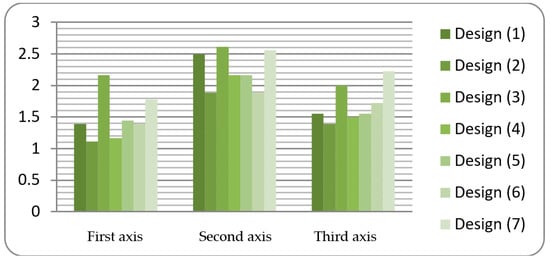
Figure 1.
Comparison of the arithmetic mean values of the axes of the pre-designs.

Table 2.
Designs showing the traditional method of employing Arabic calligraphy with drawings and wood texture.
- Second: Comparison between the arithmetic mean values of the three axes of the dimensional designs from 8:14
Figure 2. A comparison of the arithmetic mean values of the study axes for the dimensional designs. From the figure, it is clear that the average values of the first and second axes are relatively high for all designs compared to the third axis, indicating the positive impact of employing artificial intelligence applications in designing furniture elements using the art of calligraphy, especially for the ninth, tenth, twelfth, and thirteenth designs, while the arithmetic mean value for the rest of the designs decreased by a somewhat small percentage, indicating that the designs positively express the capabilities of artificial intelligence applications and their impact on designing furniture elements using the art of Arabic calligraphy and the rise in innovative and creative artistic capabilities and formative skills. Moreover, the designs from (8–14) in Table 3 show the post-test using the modern method and employing artificial intelligence technology for wood material in producing interior furniture elements.
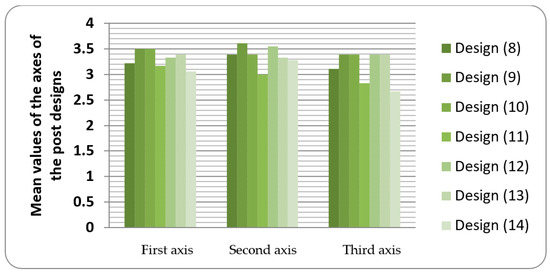
Figure 2.
Comparison of the arithmetic mean values of the dimensional design axes.

Table 3.
Shows some of the three-axis designs (function, aesthetics, and sustainable furniture elements proposed through artificial intelligence).
- -
- To compare the general arithmetic averages of the axes of the arbitration card for the pre-and post-designs, the researchers used the arithmetic averages to reveal these differences. Figure 3 and Table 4 show these results.
 Figure 3. Comparison of the general arithmetic mean values for the pre-and post-designs.
Figure 3. Comparison of the general arithmetic mean values for the pre-and post-designs. Table 4. Overall arithmetic mean (mean of means) for the axes of the pre- and post-designs.
Table 4. Overall arithmetic mean (mean of means) for the axes of the pre- and post-designs.
Figure 3 shows a comparison of the values of the general arithmetic mean of the axes of the arbitration card for the pre-and post-designs. From the figures, it is clear that the values of the general arithmetic mean for all post-designs are higher than the pre-designs, which indicates that the post-designs achieved positive trends for the questionnaire items about the pre-designs. The results of the general average for all axes show the achievement of the aesthetic and functional aspects of the wood material in the design of furniture elements and the increase in creative abilities and the degree of employment of those abilities through artificial intelligence applications.
- -
- To compare the values of the general arithmetic mean (average of averages) for the three axes of the pre-and post-designs, Table 4 and Figure 4 show a comparison of values of the general arithmetic mean (average of averages) for each axis of the questionnaire for the pre- and post-designs. From the table and figure, it is clear that the values of the general arithmetic mean for all axes of the post-designs are higher, meaning that they achieved more positive trends compared to the pre-designs, which confirms the positive impact of artificial intelligence applications and the reflection of their impact on unleashing innovative and creative capabilities through designing unique and non-stereotypical furniture elements.
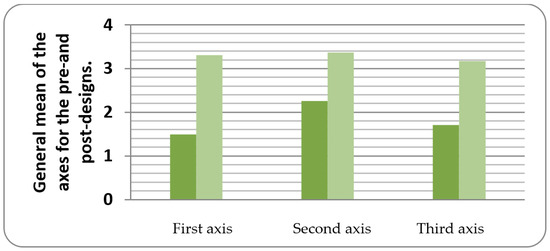 Figure 4. Comparison between the values of the general arithmetic mean of the axes of the pre- and post-designs.
Figure 4. Comparison between the values of the general arithmetic mean of the axes of the pre- and post-designs.
The second question was as follows: What is the degree of impact of artificial intelligence applications on the design of furniture elements? To verify the validity of the study hypothesis for the first axis (furniture elements), which states “there is no impact of artificial intelligence applications on the design of furniture elements”, the researchers compared the pre- and post-designs and used arithmetic averages to reveal the use of artificial intelligence applications in saving time and effort and developing design skills for furniture elements as follows:
- First, the pre-designs:
The arithmetic mean of the first axis of the questionnaire axes was compared for the pre- and post-designs, which is related to the impact of artificial intelligence applications in the design of furniture elements. From the presentation of the previous results related to the results of the pre-experiment for the first axis and Table 2 and Figure 1, Figure 2, Figure 3, Figure 4 and Figure 5 to (5) and the analysis of variance, it is clear that there are no statistically significant differences between the averages of the answers of the study’s arbitrators’ items towards the pre-experiment for the design from the first to the seventh for the first axis. The arbitrators’ answers ranged between the presence of negative trends for the first, fifth, sixth, fourth, and second designs, as the general averages for those designs reached 1.8148, 1.7222, 1.6667, 1.6111, and 1.463, respectively, and the presence of relatively moderate trends for the third and seventh designs, which indicates the agreement of the study’s arbitrators in the opinion that the pre-designs did not achieve positive trends. The standard deviation value reached 0.558, less than the significance level of 0.05 or 0.01 at a confidence level of 95% or 99%, respectively. As for the third design, Table 2 shows that the third design achieved a somewhat average value compared to the rest of the tribal designs. The researchers believe that may be due to the similarity of the methods of processing the idea in the third design—unintentionally—with one of the Arabic calligraphy decoration units due to their abundance, variation in shapes, and spread.
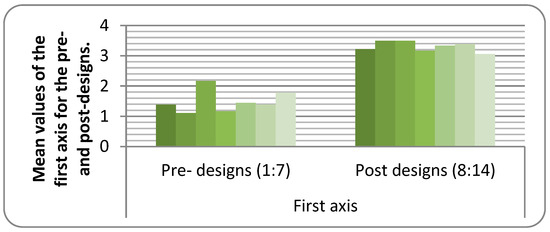
Figure 5.
Comparison of the arithmetic mean values of the first axis for the pre- and post-designs.
Table 4 shows that the average results of the pre-experiment recorded 1.492063 out of 4, which indicates the low degree of impact of artificial intelligence applications in the design of furniture elements for all pre-experiment designs. The reasons for the failure of the pre-experiment designs to achieve positive trends can be associated to the lack of familiarity with the design capabilities of artificial intelligence applications, as researchers attribute this to the lack of interest in these applications, and in collecting them, analyzing them, training on them, displaying them, and introducing them in cultural and educational forums, as well as the lack of interest in showing them and employing them in design processes like the rest of the most famous uses and fields. The results confirm that the heritage units of Arabic calligraphy do not appear clearly and appropriately in the designs of the pre-experiment. If the results indicate that the design does not achieve positive trends in reviving Arabic calligraphy and employing it in a more modern way, researchers believe that the reason for this may be due to the lack of a degree of awareness of the cultural heritage of Arabic calligraphy and is not an indicator of neglect for cultural origins or a desire to neglect and move away from the heritage of the art of calligraphy. This is confirmed by the results of the post-experiment as follows.
- Second: Post-test designs:
The results of the post-test for designs from the eighth to the fourteenth, seen in Table 3 and Figure 1, Figure 2, Figure 3, Figure 4 and Figure 5, when analyzing the variance, show the presence of statistically significant differences between the averages of the answers of the study’s arbitrators’ items towards the post-test for the design from the eighth to the fourteenth for all study axes. The arbitrators’ responses agreed on the presence of positive trends for the eighth, ninth, tenth, eleventh, and twelfth designs, as the general averages for those designs reached 3.222, 3.5, 3.5, 3.167, and 3.333, respectively, which indicates the agreement of the study’s arbitrators in the opinion that the post-test designs achieve positive trends. Figure 2 and the average table for the study axes (3) show a comparison of the arithmetic average values for the study axes for the dimensional designs. The figure shows the high values of the averages of the first axis, as the average value was recorded at 3.309524 out of 4, which indicates the presence of strong positive trends and shows the positive impact of employing artificial intelligence applications for the art of Arabic calligraphy as one of the heritage components on the performance of designers of furniture elements, and the high level of skills in employing the art of Arabic calligraphy for the designs of the dimensional experiment. The high values of the arithmetic average for all designs of the dimensional experiment indicate that the designs have become a positive expression of awareness of the importance of employing the art of Arabic calligraphy and the desire to use it as one of the sources of decoration, as researchers believe that this may be a strong indicator of interest in local culture and longing to preserve the cultural heritage and civilizational legacy.
The researchers also interpret these results as a significant increase in the level of awareness of the capabilities of artificial intelligence for all designs in the post-experiment, as Table 3 shows that the post-designs achieved positive values compared to all pre-designs. The researchers attribute this to the clarity of the design features in the visual inventory of designers and the reflection of this in the ease of employing the art of calligraphy in design through artificial intelligence programs and applications, with awareness and intent regarding the importance of preserving the art of calligraphy in sustainable furniture elements. The researchers also believe that the variation in the shapes of these lines, their abundance, and the difference in their shapes and diversity are a major reason for the demand for employment in the designs presented for the post-experiment.
Regarding the hypothesis of a relationship between the impact of employing artificial intelligence applications on saving time and effort and developing design skills for furniture elements, the results proved the validity of this hypothesis.
The third question was as follows: What is the degree of achievement of the aesthetic and functional aspect of wood material in the design of furniture elements? To verify the validity of the study hypothesis for this axis (aesthetic and functional) and its text, which states “there is no degree of achievement of the aesthetic and functional aspects of wood material in the design of furniture elements”, the researchers compared the pre- and post-designs and used arithmetic averages to reveal the use of artificial intelligence applications in saving time and effort and developing design skills, the aesthetic and functional aspect, and other variables such as the quality and diversity of these designs, as follows:
- First: Pre-designs:
A comparison was conducted between the arithmetic mean of the second axis of the arbitration card axes for the pre-and post-designs to develop the skills of employing the art of calligraphy with artificial intelligence programs in furniture and achieving the aesthetic and functional aspect of wood material in designing furniture elements. From the presentation of the previous results related to the results of the pre-experiment for the second axis, Figure 6, Table 2, and the analysis of variance, it is clear that there are no statistically significant differences between the averages of the answers of the study’s arbitrators’ items towards the pre-experiment for the design from the first to the seventh for the second axis. The arbitrators’ answers ranged between the presence of negative trends for the first, fifth, sixth, fourth, and second designs, as the general averages for those designs reached 2.5, 2.1666, 2.1666, 1.6111, and 1.8866, respectively, and the presence of relatively moderate trends to some extent for the third and seventh designs, respectively 2.6111 and 2.556, which indicates the agreement of the study’s arbitrators in the opinion that the pre-design did not achieve positive trends. The standard deviation value reached 1.089, which is less than the significance level of 0.05 or 0.01 at a confidence level of 95% or 99%, respectively.

Figure 6.
Comparison between the arithmetic mean values of the second axis for the pre-and post-designs.
The results of the study show that the designs of the pre-sample achieved somewhat average trends, while in the post-experiment, they achieved positive trends, which confirms the support of artificial intelligence applications for developing sustainable wooden furniture elements. It facilitates dealing with decorative units with flexibility and efficiency. As for the designs contributing to achieving design quality and diversity in employing the art of Arabic calligraphy, Table 2 of the averages for the study axes shows the results of the study achieving average trends regarding the pre-experiment. It is also clear that there are somewhat average trends by the arbitrators, as the results indicate an average of 2.253968. The researchers attribute the impact of the great interest in using modern technologies and artificial intelligence applications, means of communication, and computers to the designers’ positive skills in dealing with electronic programs, even if they were not previously defined. As for the ability of artificial intelligence applications to reduce waste resulting from wood processing, the results of the study proved the achievement of positive trends by the arbitrators, as the results indicate that this may be due to the researchers reviewing some of their designs to help generate ideas, their diversity, and their flexibility. The results of the study show that the designs of the pre-sample achieved somewhat average trends, while in the post-experiment, they achieved positive trends.
Secondly, dimensional designs: A comparison between the arithmetic mean of the second axis of the questionnaire axes for the pre-and post-designs; the aesthetic and functional aspect of wood material in the design of furniture elements; the presentation of the previous results related to the results of the post-experiment for the second axis, seen in Table 3, Figure 1, Figure 2, Figure 3, Figure 4, Figure 5 and Figure 6; and through the analysis of variance, it is clear that there are statistically significant differences between the averages of the answers of the study’s arbitrators’ items towards the post-experiment for the design from the eighth to the fourteenth of the second axis, and the arbitrators’ answers recorded positive trends for the post-experiment designs for the ninth, tenth, twelfth, thirteenth, eighth, eleventh, and fourteenth designs, respectively, with averages of 3.5, 3.4259, 3.4259, 3.3704, 3.2407, 3, and 3. There are positive trends for all designs, which indicates the agreement of the study’s arbitrators in the opinion of achieving the post-design, as the standard deviation values reached 0.5671, 0.5635, 0.6936, 0.5148, 0.523, 0.9398, and 0.9858, which are less than the significance level of 0.05 or 0.01 at the 95% or 99% confidence level, respectively. From Table 4 of the average averages for the second axis, the effect of employing digital technologies appears through the ability to quickly absorb and respond positively to designers when researchers use artificial intelligence programs in furniture design, as the averages show the post-experiment to record a percentage of 3.365079 out of 4, which is the highest percentage recorded for all study axes. The researchers believe that the skill capabilities using digital technologies in mobile phones have greatly affected the study results, contributing to the development of capabilities and skills for employing furniture efficiently. The reason for this can be attributed to the emphasis on the role of computers in developing creative capabilities and the necessity of training and developing university students and professors in the field of computers and the Internet, eliminating computer illiteracy in universities, and developing their capabilities and skills. These skills are considered the primary source in generating, storing, retrieving, and disseminating knowledge in light of the cultural globalization that accompanied the development of information technology [21].
To answer the fourth question:
To what extent do artificial intelligence applications contribute to achieving heritage sustainability through the art of Arabic calligraphy?
To verify the validity of the study hypothesis for this axis (sustainability), which states “there is no contribution of artificial intelligence applications to achieving heritage sustainability through the art of Arabic calligraphy”, the researchers compared the pre- and post-designs and used arithmetic averages to reveal the use of artificial intelligence applications and the innovation of furniture designs inspired by the art of Arabic calligraphy and the reflection of this on increasing awareness of the concept of heritage sustainability and preservation, as follows:
Figure 7 shows a comparison of the arithmetic mean values for the third axis related to preserving cultural heritage and increasing awareness of it to achieve the goal of heritage sustainability with the generation of multiple design ideas based on the art of Arabic calligraphy for tribal and post-template designs. From Table 4, for the average of the averages for the third axis, it is clear that the arithmetic mean values for all tribal designs were recorded at somewhat average ratios, as trends achieved ratios lower than the average and recorded a value for all axis items of 1.706349 out of 4, which indicates the agreement of the arbitrators that the designs of the tribal experiment did not achieve the concept of preserving cultural heritage and employing Arabic calligraphy in traditional ways for furniture design elements. There are also no design signals showing increased awareness and preservation of heritage through furniture designed from the art of Arabic calligraphy from the first to the seventh design, and there were no design ideas generated in traditional ways that employ the art of Arabic calligraphy in furniture designs for the tribal experiment.

Figure 7.
Comparison of the arithmetic mean values of the third axis for the pre- and post-designs.
Regarding the results of the post-experiment for the third axis, the average results recorded in Table 4 indicate the presence of positive trends for the vocabulary and answers of the study judges towards all items of the questionnaire axes for the post-experiments. The arithmetic mean value for the three items of the axis was recorded at 3.166667 out of 4, as the results of (the third axis) show the presence of innovation in the designs in terms of the method of employing units and elements. High percentages of arithmetic mean values were recorded for all post-designs, as they indicate the agreement of the judges on achieving the post-experiment designs of the principle of preserving cultural heritage and the impact of employing Arabic calligraphy using artificial intelligence applications for furniture design elements. The results show an increase in awareness and preservation of heritage through furniture designed from the art of Arabic calligraphy from the eighth to the fourteenth design using artificial intelligence applications. There are also emerging design ideas due to the technical and design capabilities of artificial intelligence applications with the employment of Arabic calligraphy in furniture designs for the post-experiment.
AI contributed to efficient material usage and lessened design waste, improved creativity and heritage preservation, and facilitated the faster generation of diverse and functional furniture models. These outcomes are supported by data in Table 4 and Figure 3, Figure 4, Figure 5, Figure 6 and Figure 7.
Regarding the validity of the hypothesis for the third question, the results indicate a positive relationship, as artificial intelligence applications helped create furniture designs inspired by the art of Arabic calligraphy. The design results show an increase in awareness of preserving heritage in a modern way that is consistent with the requirements of the era, which proves the validity of the hypothesis.
While AI presents potential for creative exploration in furniture design, there are several challenges and limitations inherent in its use. One primary concern is the loss of human intuition and cultural sensitivity. Although AI can generate design concepts based on predefined inputs, it may not fully grasp the subtleties and emotional resonance embedded in traditional art forms, such as Arabic calligraphy. This can lead to designs that, while visually innovative, may lack the deep cultural and symbolic meaning that a human designer would intuitively incorporate.
Another limitation is the technical and practical constraints of translating AI-generated designs into tangible furniture. Although AI tools like DALL-E can produce visually compelling concepts, the actual manufacturing process often requires adjustments to accommodate material properties, ergonomics, and structural integrity. For instance, AI-generated designs may propose forms that are difficult to construct with existing manufacturing methods or materials, necessitating further human intervention in the adaptation process.
Additionally, AI’s dependency on data is a crucial limitation. The model’s output is largely shaped by the data it has been trained on. In this study, the AI-generated designs were influenced by the specific visual language of Arabic calligraphy artwork provided by the authors. However, the diversity of AI-generated designs is inherently limited by the dataset’s scope and the specificity of the input provided. The use of diverse datasets or more dynamic training sets may enhance the variety and creativity of the generated designs, but this remains a challenge in the current state of AI technology.
Finally, ethics and originality remain ongoing discussions in AI-driven design. As AI continues to evolve, questions about the ownership of designs, the potential for plagiarism, and the role of AI in the creative process become more pronounced. Ensuring that AI is used ethically and transparently remains a significant challenge for the design community.
11. Recommendations
- -
- This study recommends that designers and researchers should design using artificial intelligence applications in the stages of interior design and furniture processes, as it enables multiple and diverse design ideas from which to choose the best and most appropriate, which helps save effort and time.
- -
- Researchers insist on the importance and necessity of learning artificial intelligence and studying the use of its applications related to interior design and furniture elements within the curricula for interior design students in faculties of design and arts.
- -
- More future studies should be conducted on how to employ artificial intelligence technology and use the art of Arabic calligraphy in the field of interior design and furniture.
12. Conclusions
- -
- The design experiments of the furniture elements of the current study proved that it is possible to manipulate the three-dimensional proportions of the Arabic calligraphy letters of the wall panels and create innovative design forms that can be employed in interior design and furniture.
- -
- The design experiments showed that Arabic calligraphy has high flexibility, which allows it to be modified in design and function to match the design requirements of the furniture elements.
- -
- This study explored new compositions and configurations inspired by the art of Arabic calligraphy in a digital environment, with the ability to integrate these innovative design ideas for furniture elements in contemporary environments.
- -
- This study is an attempt to preserve cultural identity by integrating the art of Arabic calligraphy into furniture elements with contemporary design ideas.
- -
- These design experiments for furniture elements help to transfer the Arab cultural heritage to other communities and facilitate communication between people from diverse backgrounds.
One limitation of this study is the absence of user testing or real-world validation of the AI-generated furniture concepts. While the designs were reviewed for structural and functional feasibility, further research will involve physical prototyping and user feedback sessions to assess comfort, usability, and cultural acceptance in practical settings.
Author Contributions
Methodology, I.M. and D.A.A.M.; Formal analysis, R.A.; Investigation, M.A.M.A.; Writing – original draft, A.S.A. and K.A.-S. All authors have read and agreed to the published version of the manuscript.
Funding
This research was funded by the Deanship of Scientific Research, Vice Presidency for Graduate Studies and Scientific Research, King Faisal University, Saudi Arabia [Grant No. KFU251648].
Institutional Review Board Statement
The study was conducted in accordance with the Declaration of Helsinki, and approved by the Ethics Committee of King Faisal University protocol code ERS_2024_6735 and date of approval was 23 October 2024.
Informed Consent Statement
Informed consent was obtained from all subjects involved in the study.
Data Availability Statement
The authors declare that all other data supporting the findings of this study are available within the article. Informed consent was obtained from all individual participants included in the study.
Conflicts of Interest
This manuscript has not been published or presented elsewhere, in part or in entirety, and is not under consideration by another journal. There are no conflicts of interest to declare. On behalf of all authors, the corresponding author states that there are no conflicts of interest.
Appendix A. Analysis Card of the Pre- and Post-Implemented Designs for the Study Axes (Beauty and Function, Sustainability, Furniture Elements)
| Axes | N | Questions | 1 | 2 | 3 | 4 | 5 | 6 | 7 | 8 | 9 | 10 | 11 | 12 | 13 | 14 |
| Axis I: Artificial intelligence applications. | 1 | Artificial intelligence applications have contributed to saving effort and time and developing the design skills of furniture designers. | ||||||||||||||
| 2 | Artificial intelligence applications have helped in designing unique and atypical furniture items. | |||||||||||||||
| 3 | Artificial intelligence applications have contributed to improving design and innovation in the design of furniture elements. | |||||||||||||||
| Axis II: The aesthetic and functional aspect of wood in the design of furniture elements. | 4 | Artificial intelligence applications have supported the development of sustainable wooden furniture items. | ||||||||||||||
| 5 | The designs contributed to achieving design quality and diversity in employing the art of Arabic calligraphy. | |||||||||||||||
| 6 | AI applications reduce waste from wood processing. | |||||||||||||||
| Axis III:Heritage sustainability. | 7 | Artificial intelligence applications have helped preserve cultural heritage through furniture elements designed from Arabic calligraphy. | ||||||||||||||
| 8 | The designs show an increased awareness of preserving heritage in a modern way that suits the requirements of the times. | |||||||||||||||
| 9 | Artificial intelligence applications have contributed to generating multiple design ideas based on the art of Arabic calligraphy. |
References
- Al-Haqqan, D.N.M. Artificial Intelligence and its Effectiveness in Developing Interior Design Skills. J. Arts Lit. Humanit. Soc. Sci. 2023, 88, 117–126. [Google Scholar]
- Ezzedine, H. Applications of Arabic calligraphy in modern interior design. J. Hum. Sci. 2017, 18, 253–270. [Google Scholar]
- Mahmoud, A.H.A.; Ali, J.; Ahmed, K.M. The Philosophy of Organicism in Islamic Art and the Arts of Arabic Calligraphy: An Introduction to Enriching the Field of Decorative Design and Affirming Arab Identity. South-South Dialogue 2025, 8. [Google Scholar]
- Alashari, D.M.; Hamzah, A.R.; Marni, N. Islamic art and language as a source of inspiration leading to traditional Arabic calligraphy art. Umra. Int. J. Islam. Civilizational. Stud. 2019, 6, 33–45. [Google Scholar] [CrossRef]
- Ahmed Abdel Latif, A. Artificial Intelligence Applications in Sustainable Furniture Design. Arab. Int. J. Digit. Art. Des. 2024, 3, 181. [Google Scholar]
- Zahra, N. Role of artificial intelligence technology in the development of furniture design Process. Int. Des. J. 2023, 13, 503–520. [Google Scholar] [CrossRef]
- Aboushall, D.; Jalagat, R. Artificial ıntelligence’s contribution to the furniture design process development. Int. J. Humanit. Educ. Res. 2024, 6, 123–148. [Google Scholar]
- Hassan, M.A.S. The Role of Artificial Intelligence in Reshaping the Creative Process. J. Art. Des. 2025, 3, 182–213. [Google Scholar]
- Afifi. Artificial intelligence in sustainable furniture design: Challenges and opportunities. Int. Arab. J. Digit. Art. Des. 2024, 3, 181–198. [Google Scholar]
- Mahmoud, G.Z. Artificial Intelligence and Enhancing Creativity in Graphic Design. Al-Acad. J. 2024, 399–410. [Google Scholar] [CrossRef]
- Ahmad, A.A. Contemporary Islamic Calligraphy Learning. In Proceedings of the 3rd International Conference on Arts and Design Education (ICADE 2020), Zoom Webinar, Online, 15 September 2020. [Google Scholar]
- Hamdy, Y. application of artificial intelligence in the development of Interior Design Operations Management. J. Des. Sci. Appl. Arts 2022, 3, 239–245. [Google Scholar] [CrossRef]
- Mansour, O.; Netti, R. The Arabic calligraphy. An identifying parameter in space, time and contents-La calligrafia araba. Un parametro identificativo nel tempo, nello spazio e nei contenuti. In Grafiche Graphics; Springer: Berlin, Germany, 2019; Volume 1, pp. 90–91. [Google Scholar]
- Kattan, L.M. Sustaining cultural identity through arabic calligraphy: A critical reading of nasser al-salem’s artworks. WIT Trans. Built Environ. 2020, 197, 211–222. [Google Scholar]
- Attmann, O. Green Architecture: Advanced Technologies and Materials; McGraw-Hill: New York, NY, USA, 2010. [Google Scholar]
- Sultan, L.; Qassab, A.S.; Moualla, S. The impact of using Arabic calligraphy in contemporary architectural composition (function-form). Tishreen. Univ. J.-Eng. Sci. Ser. 2022, 44, 267–285. [Google Scholar]
- Al-Ashoush; Mohammed, B.; Abdul-Qader; Abdul-Sabour, W. Using Arabic Calligraphy in Designing Logos of Arab Universities. Unpublished Master’s Thesis, Middle East University, Amman, Jordan, 2018. Available online: http://search.mandumah.com/Record/903411 (accessed on 12 December 2024).
- Mustafa, T.M. Arabic letters as a formative element in contemporary murals in the Arab world and their role in preserving heritage and identity. J. Archit. Arts Humanit. 2022, 7, 142–171. [Google Scholar]
- Ali; Mohamed, H.I.E.E.-D. Applications of Arabic Calligraphy in Modern Interior Design. J. Humanit. 2017, 18, 253–270. Available online: http://search.mandumah.com/Record/804989 (accessed on 12 December 2024).
- Al-Hazmi, N.N.N. The effectiveness of artificial intelligence applications in furnishing the interior space of the home. J. Arts Lit. Humanit. Soc. Sci. 2023, 98, 430–442. [Google Scholar]
- Al-Jamal, D.S.S. The role of computers in developing creative thinking among students from the perspective of technology teachers in the Directorate of Education in South Hebron. Al-Quds Open Univ. J. Humanit. Soc. Res. 2015, 2. [Google Scholar] [CrossRef]
Disclaimer/Publisher’s Note: The statements, opinions and data contained in all publications are solely those of the individual author(s) and contributor(s) and not of MDPI and/or the editor(s). MDPI and/or the editor(s) disclaim responsibility for any injury to people or property resulting from any ideas, methods, instructions or products referred to in the content. |
© 2025 by the authors. Licensee MDPI, Basel, Switzerland. This article is an open access article distributed under the terms and conditions of the Creative Commons Attribution (CC BY) license (https://creativecommons.org/licenses/by/4.0/).

